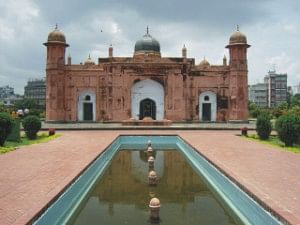Law letter
Preserve Lalbagh Kella
 Archeological sites in Bangladesh needs be to protected and preserved by applying environmental and archeological law. Rajdhani Dhaka is standing on its 400th year. In that account, Dhaka is older than any other cites of the country. It retains a long history. Many rulers reigned and made themselves unforgettable by their illustrious constructions. Lalbagh Kella is one of the historic constructions of Mughal-era (1526-1857). It was built by Shahesta Khan, the then Subehdar of Subeh Bangla. Mughal emperor Aurongozeb (1658-1707) entrusted him the charge of Subehdar of Bangla. Shahesta Khan was famous and well known for his ability to afford the people foodstuffs in a much underrated price. He built Lalbagh Kella in 1688. So, Lalbagh Kella is very important historical and archeological site in Dhaka city. It is considered as a great heritage of Bangladesh for it's innovative scriptures and artistic outlook. Unfortunately, land grabbers and land encroachers gradually are capturing land pertaining to Lalbagh Kella.
Archeological sites in Bangladesh needs be to protected and preserved by applying environmental and archeological law. Rajdhani Dhaka is standing on its 400th year. In that account, Dhaka is older than any other cites of the country. It retains a long history. Many rulers reigned and made themselves unforgettable by their illustrious constructions. Lalbagh Kella is one of the historic constructions of Mughal-era (1526-1857). It was built by Shahesta Khan, the then Subehdar of Subeh Bangla. Mughal emperor Aurongozeb (1658-1707) entrusted him the charge of Subehdar of Bangla. Shahesta Khan was famous and well known for his ability to afford the people foodstuffs in a much underrated price. He built Lalbagh Kella in 1688. So, Lalbagh Kella is very important historical and archeological site in Dhaka city. It is considered as a great heritage of Bangladesh for it's innovative scriptures and artistic outlook. Unfortunately, land grabbers and land encroachers gradually are capturing land pertaining to Lalbagh Kella.
Recent news about the Kella has attracted our attention. One Haji Abul Hashem has clamed portion of land precisely within the site. On March 16, 2009, Mr. Hashem filed a writ petition against the Archaeological Department following opposition of the Fort authorities when he took initiative to raise a building.
In its verdict on October 10, 2010, the High Court (HC) directed the government to “conduct survey within three months to identify and demarcate the actual area of Lalbagh Kella with cooperation of the Director General (DG) of Land Survey Department. The court also asked the authorities to “demolish the construction within territory of Lalbagh Kella”. The court also ordered to construct a five metre wide walkway, if necessary, by acquiring the land in accordance with law to save Lalbagh Kella.
Lalbagh Kella is described in the books to be on the bank of Buriganga in the northeastern part of Dhaka. But one cannot see the Fort now from the other side of the river. Built 322 years ago, the Fort now stands threatened, as 40 old buildings have come up in the last about four decades alongside its southern and western vicinity. As a result, no part of the Fort's southern and western wall can be seen at present from outside.
Now let us have a glimpse on the legal regime in relation to preservation of archeological site. The following provisions of law can be pointed out:
1. Section 5(1) of the Environmental Conservation Act 1995 has laid down that if the government is satisfied that an area is under an environmentally critical situation or is threatened to be in such situation, the government may, by notification in the official Gazette, declare such area as an ecologically critical area.
2. The Environment Conservation Rules 1997 in section 3(1) stipulates that the government shall take the following factors into consideration while declaring any area as 'Ecologically Critical, i. e. a) Human habitat, b) Ancient monument, c) Archeological site etc.
3. The Antiquity Act, 1968 has envisaged that raising any kind of new structure adjacent to any archaeological site affecting the ancient monument is totally prohibited.
4. Bangladesh is a party to the Paris Convention Concerning the Protection of the World Cultural and Natural Heritage, 1972. The objectives of the Convention, to quote from its preamble, are “to establish an effective system of collective protection of the cultural and natural heritage of outstanding universal value, organized on a permanent basis and in accordance with modern scientific methods”. In essence the Convention casts a responsibility on the state parties to take necessary measures for the identification, protection, conservation cultural and natural heritage belonging to them for the future generations. Bangladesh ratified this convention in 1983. So, pact should be served on good faith.
It is submitted that the government should take necessary action against the Lalbagh Kella encroachers. It is to be protected for a reminiscence of the past, to understand the historical legacy---to better grasp the gradual transformation of the psychology of an old city.
Md. Mokarrom Hossan PhD Fellow, Dhaka University